Measuring HR effectiveness is essential for understanding how well your HR team supports business goals.
It goes beyond tracking routine activities by focusing on metrics that reveal how HR impacts employee engagement, retention, and overall productivity.
By identifying key performance indicators specific to your organization, you can pinpoint what’s working and where improvements are needed. This clarity helps optimize recruitment, development, and retention strategies, making HR a true strategic partner.
In this article, you’ll learn the most important HR metrics to measure, their practical application, and how they drive better workforce and business outcomes.
Key Takeaways
- HR effectiveness is key: Measuring HR performance helps align workforce goals with business objectives, driving overall success.
- Track the right metrics: Focus on key metrics like employee engagement, turnover, and quality of hire to measure HR impact.
- Benchmark against industry standards: Use internal and external benchmarking to compare HR performance and identify areas for improvement.
- Leverage technology for insights: Utilize platforms like Synergita to track, analyze, and improve HR metrics in real time for better decision-making.
What Does HR Effectiveness Really Mean?
Measuring HR effectiveness is about assessing how well HR practices support business goals and improve workforce outcomes.
It requires focusing on meaningful data that reflects the real impact of HR activities on employee engagement, retention, productivity, and operational efficiency.
Why Measure HR Effectiveness?
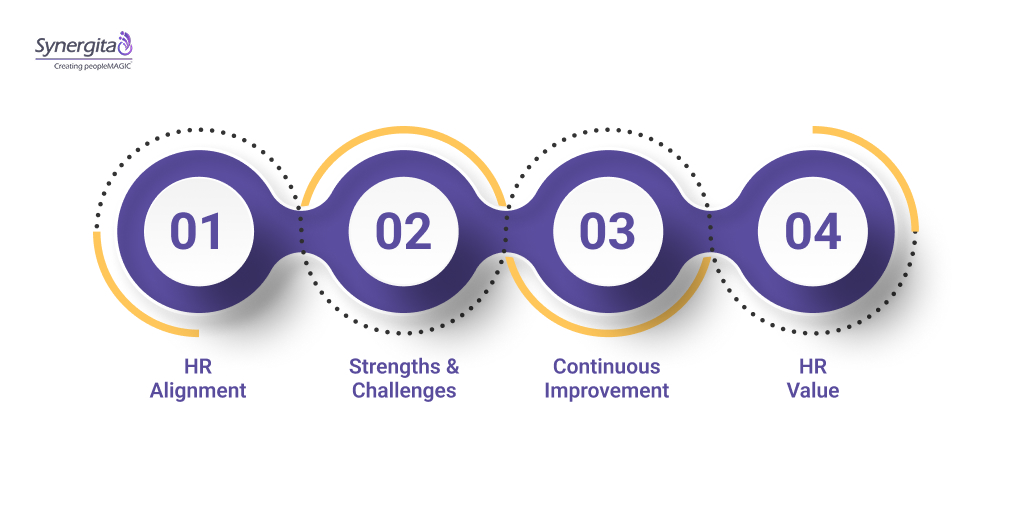
- Align HR with Business Strategy: Measuring effectiveness ensures HR initiatives support overarching organizational goals.
- Identify Strengths and Challenges: Data highlights what’s working and areas needing improvement.
- Drive Continuous Improvement: Metrics guide informed decisions for optimizing recruitment, development, and retention.
- Demonstrate HR Value: Quantifying results helps prove HR’s contribution as a strategic partner rather than just an administrative function.
Key Elements of Effective Measurement
Successful HR measurement depends on a strong framework:
- Clear Problem Identification: Understand specific HR challenges or opportunities before selecting metrics.
- Relevant Metric Selection: Choose KPIs tied to organizational priorities and workforce needs.
- Robust Data Collection: Ensure accuracy and consistency through technology and defined processes.
- Insightful Analysis and Action: Translate data into actionable insights to improve policies and programs.
- Ongoing Monitoring: Continuously track metrics to adapt strategies flexibly.
The Role of Technology
Modern HR platforms like Synergita simplify this process by offering:
- Real-time Dashboards: Live tracking of critical HR metrics.
- Customizable Reports: Tailored to organizational structure and goals.
- AI-powered Insights: Actionable recommendations without unnecessary complexity.
HR effectiveness starts with the right metrics. Curious how Synergita can help? Learn how it simplify HR tracking.
In the next sections, we will break down these critical HR metrics, methods to measure them accurately, and how to use them to maximize HR’s impact on your organization.
Key Metrics HR Must Track to Prove Its Worth
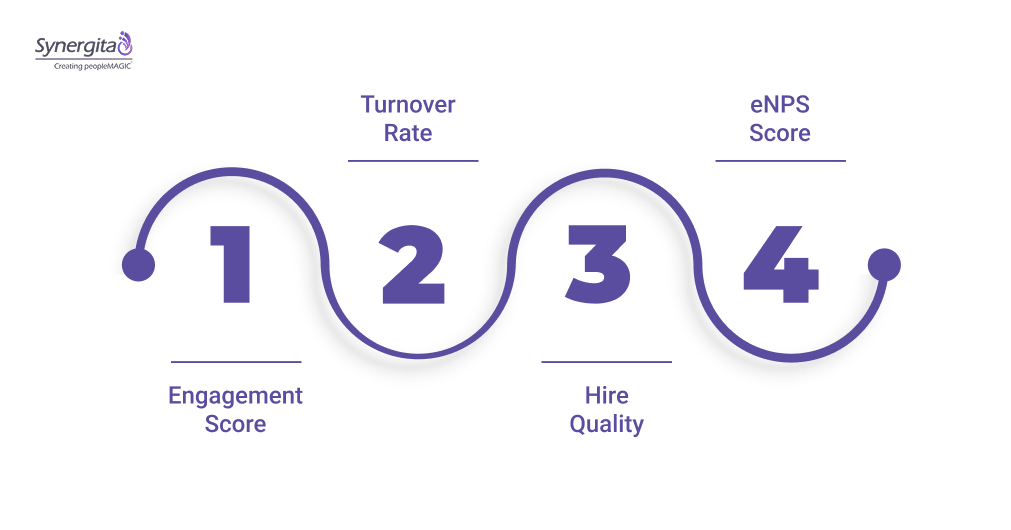
Tracking key HR metrics provides a clear view of workforce health and performance. Below are the essential HR metrics every organization should monitor to make informed decisions and drive business success.
1. Employee Engagement Score
Employee engagement reflects how emotionally committed employees are to their work and the company. High engagement boosts productivity, retention, and company performance.
How to Measure:
- Annual surveys
- Pulse surveys
- Employee Net Promoter Score (eNPS)
Why It Matters:
Engaged employees are more productive, committed, and aligned with company goals. Low engagement can lead to decreased performance and higher turnover rates.
How to Improve:
- Regular feedback sessions
- Employee recognition programs
- Clear communication about company goals and personal growth opportunities.
2. Employee Turnover Rate (Voluntary and Involuntary)
The turnover rate measures how many employees leave the organization, either voluntarily (quitting) or involuntarily (termination). High turnover increases costs and disrupts team dynamics.
How to Measure:
Turnover Rate = (Number of Employees Who Left / Average Number of Employees) * 100
Why It Matters:
High turnover leads to recruitment and training costs, loss of knowledge, and a negative impact on morale. It can indicate problems with workplace culture or management.
How to Improve:
- Conduct exit interviews to understand the reasons for leaving
- Enhance employee satisfaction through career development programs
- Improve work-life balance and offer competitive compensation.
3. Quality of Hire
Quality of hire evaluates the effectiveness of your recruitment process by assessing the performance and retention of new hires.
How to Measure:
- Performance reviews
- Retention rates
- Time to productivity
Why It Matters:
High-quality hires perform better, integrate seamlessly, and contribute positively to the team. They stay longer and provide more value to the business.
How to Improve:
- Refine your hiring process with better job descriptions and interview strategies
- Use data-driven recruitment tools
- Focus on cultural fit and alignment with organizational values.
4. Employee Net Promoter Score (eNPS)
eNPS measures employee satisfaction by asking how likely they are to recommend the company as a workplace. A higher score indicates a more satisfied and loyal workforce.
How to Measure:
- Ask employees: “On a scale of 0-10, how likely are you to recommend this company as a place to work?”
- Calculate the score by subtracting the percentage of detractors from promoters:
NPS = %Promoters − %Detractors
Why It Matters:
A high eNPS correlates with strong employee satisfaction, low turnover, and increased productivity. A low score can signal issues with leadership, culture, or employee expectations.
How to Improve:
- Act on feedback from detractors
- Address leadership or cultural issues
- Foster better communication and trust across all levels of the organization.
Engagement and turnover matter. Want better insights?See how Synergita tracks your HR metrics.
Also Read: What are the main causes of Employee Turnover?
Measure Operational Efficiency to Boost HR Impact
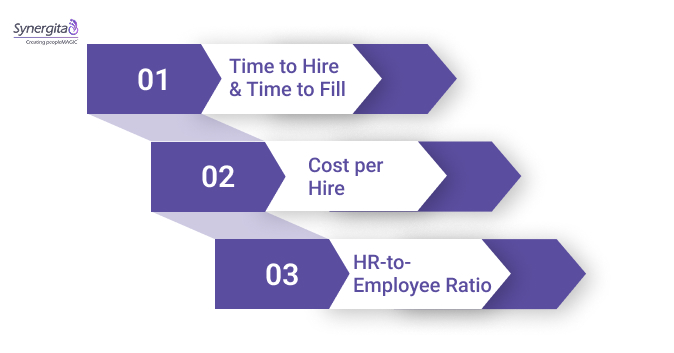
To measure HR effectiveness, it’s important to evaluate how efficiently the HR department operates.
These metrics give insight into how well HR is managing processes like recruitment, onboarding, and employee support while controlling costs.
1. Time to Hire and Time to Fill
Time to hire measures the time taken to move a candidate from application to offer acceptance. Time to fill tracks how long it takes to hire a candidate, from requisition to offer acceptance. These metrics reflect the efficiency of your recruitment process.
How to Measure:
- Track the date the job requisition is created and the date the candidate accepts the offer.
- Record the length of the recruitment process, including interviews, assessments, and final decision-making.
Why It Matters:
Delays in hiring can impact business operations, especially if there are skill gaps or critical roles that remain unfilled. A lengthy recruitment process can also discourage top talent, who may accept offers elsewhere.
How to Improve:
- Streamline recruitment processes by eliminating unnecessary steps
- Use technology to automate scheduling and communication
- Improve collaboration between HR and hiring managers to speed up decision-making.
2. Cost per Hire
Cost per hire measures the total expenditure of the recruitment process, including advertising, agency fees, recruiter salaries, and other related costs. It helps assess how cost-efficient your hiring processes are.
How to Measure:
Cost per Hire = Total Recruitment Costs / Number of Hires
This includes both direct and indirect costs such as advertising, recruiter fees, interview expenses, and onboarding costs.
Why It Matters:
Keeping recruitment costs under control is crucial for HR departments, especially in larger organizations with high turnover or frequent hiring needs. High cost-per-hire ratios can be a sign of inefficiency or poor resource allocation.
How to Improve:
- Leverage internal referrals to reduce agency fees
- Use cost-effective job boards and platforms
- Invest in technology to automate parts of the recruitment process and reduce time spent on manual tasks.
Also Read: What Key Performance Metrics for Managers are Beneficial in 2025?
3. HR-to-Employee Ratio
The HR-to-employee ratio compares the number of HR staff to the total number of employees in the organization. It helps assess if the HR department is adequately staffed to handle its responsibilities.
How to Measure:
HR-to-Employee Ratio = ( Number of HR Employees / Total Number of Employees ) * 100
This ratio varies by industry, company size, and HR functions, but a typical range is 1 HR employee for every 100 to 200 employees.
Why It Matters:
A high HR-to-employee ratio may indicate that HR is overstaffed, while a low ratio may point to an overburdened department. An imbalance can lead to inefficiencies in HR service delivery.
How to Improve:
- Evaluate if certain HR tasks can be automated or outsourced to reduce workload
- Prioritize high-impact HR activities and consider technology solutions to streamline administrative tasks
- Regularly review the ratio to ensure it aligns with company growth and HR needs.
Also Read: The Important Employee Performance Metrics
Tracking Performance and Development: What Really Matters
Measuring the performance and development of employees is crucial for understanding both individual and organizational growth.
These metrics help HR assess how well employees are performing, how effectively training programs are working, and how career progression is supported within the company.
1. Training Return on Investment (ROI)
Training ROI measures the effectiveness of learning and development programs by comparing the benefits gained to the costs incurred.
It helps determine if training efforts translate into improved employee performance and organizational success.
How to Measure:
- Calculate the total costs of training, including materials, facilitator fees, and employee time spent.
- Measure performance improvements in key areas such as productivity, efficiency, or sales post-training.
- Evaluate employee satisfaction with the training programs through surveys and feedback.
Why It Matters:
Training programs can be expensive, so it’s important to ensure that they contribute to business objectives. A high ROI indicates that training initiatives are enhancing employee skills and driving business performance.
How to Improve:
- Align training programs with business goals to ensure relevance and effectiveness
- Regularly assess the impact of training on key performance indicators (KPIs)
- Gather feedback from participants to refine future training initiatives.
2. Internal Promotion Rate
The internal promotion rate tracks the percentage of open positions filled by current employees rather than external hires. A high internal promotion rate reflects a company’s commitment to employee development and career growth.
How to Measure:
Internal Promotion Rate = Total Number of Job Openings / Number of Internal Promotions
This can be tracked across different levels of the organization and across different job functions.
Why It Matters:
Promoting from within helps retain top talent and reduces recruitment costs. It also boosts employee morale by showing that the company values career growth and internal development.
Low promotion rates may indicate stagnation or a lack of opportunity for advancement.
How to Improve:
- Create clear career development pathways and succession plans
- Provide ongoing skill development and leadership training opportunities
- Communicate opportunities for internal growth to employees.
Also Read: 9 Reasons Why Employee Performance Evaluation is Important
3. Performance Management Effectiveness
This metric assesses how well the performance management process aligns employee goals with organizational objectives and drives continuous improvement in individual performance.
How to Measure:
- Review performance appraisals, feedback frequency, and employee goal alignment.
- Measure the percentage of employees who achieve their set goals and how often performance feedback is given.
- Evaluate the effectiveness of performance discussions and development plans.
Why It Matters:
Effective performance management ensures that employees stay focused on business priorities and receive the necessary support to improve.
Poor performance management processes can lead to misaligned goals, decreased productivity, and frustration.
How to Improve:
- Implement continuous feedback mechanisms and regular check-ins
- Align individual goals with team and company objectives to create a sense of purpose
- Use data and analytics to track performance and make data-driven decisions.
Aligning metrics with goals is key. Ready to take control of your HR data? Start using Synergita today.
Also Read: Metrics that Matter: Tracking Progress and Driving Organizational Growth with OKRs
Connecting HR to the Bottom Line: Financial Metrics You Need
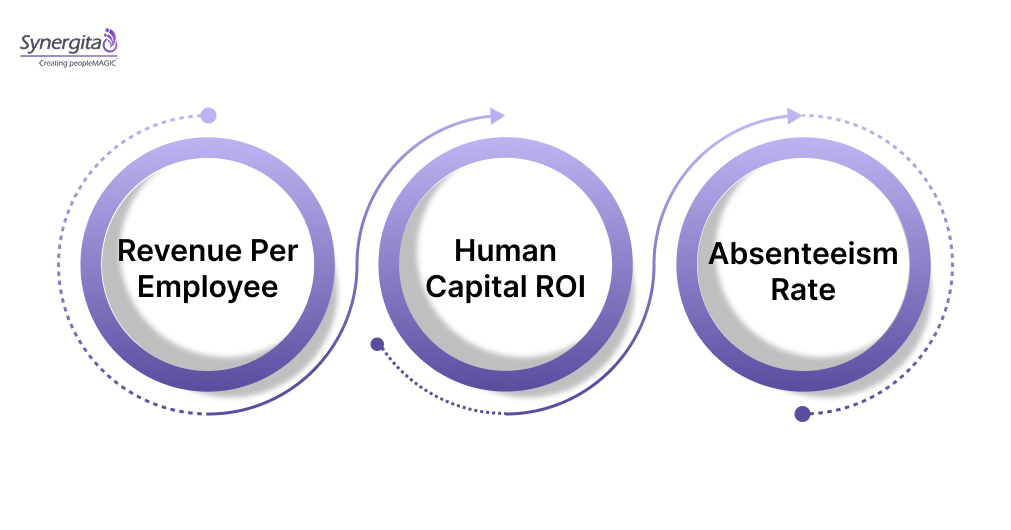
Understanding the financial impact of HR activities is essential for demonstrating the value of HR initiatives and aligning them with organizational goals.
These metrics connect HR performance with key business outcomes like revenue, profitability, and cost management.
1. Revenue per Employee
Revenue per employee is a measure of how much revenue is generated for each employee in the organization. It reflects workforce productivity and efficiency.
How to Measure:
Revenue per Employee = Total Revenue / Total Number of Employees
This metric should be tracked across different departments to assess the performance of individual teams and identify areas for improvement.
Why It Matters:
High revenue per employee indicates that the company is using its workforce effectively, driving growth and maximizing productivity. It can also highlight areas where talent gaps might exist or where operational inefficiencies need addressing.
How to Improve:
- Optimize workforce utilization by focusing on the most productive employees
- Invest in technology and training to increase employee productivity
- Align individual goals with company performance objectives to boost output.
2. Human Capital ROI
Human Capital ROI measures the return on investment in human resources. It calculates the value generated by HR initiatives in relation to the costs associated with them.
How to Measure:
Human Capital ROI = (Revenue from Employees−Total HR Costs/ Total HR Costs) * 100
This formula helps track the profitability of HR investments, including recruitment, training, and development programs.
Why It Matters:
This metric demonstrates how effectively HR investments contribute to the bottom line. A high ROI indicates that HR strategies are delivering substantial value, while a low ROI suggests that HR initiatives may need to be reassessed.
How to Improve:
- Focus on programs that drive measurable outcomes, such as employee training, performance management, and engagement
- Regularly evaluate HR programs to ensure they align with business objectives
- Optimize HR spending to maximize efficiency and outcomes.
3. Absenteeism Rate and Associated Costs
Absenteeism rate measures the frequency and duration of employee absences. High absenteeism can indicate low employee engagement or health-related issues, both of which can affect overall productivity.
How to Measure:
Absenteeism Rate = (Total Days Absent / Total Available Workdays) * 100
This metric should be tracked over time to identify trends and address recurring issues.
Why It Matters:
High absenteeism can disrupt workflows, decrease productivity, and lead to additional costs associated with temporary replacements. It may also indicate underlying issues such as low morale or health problems.
How to Improve:
- Implement wellness programs to improve employee health and reduce absenteeism
- Foster a positive work culture that encourages attendance
- Offer flexible work arrangements to support employee well-being.
Also Read: Are You Tracking the Right Metrics for Employee Retention in 2025?
How to Track Diversity, Equity & Inclusion Success
Diversity, equity, and inclusion (DEI) are critical for building a strong, innovative, and productive workforce.
Measuring progress in these areas ensures that the organization is not only compliant with legal standards but also fosters an inclusive environment that drives business success.
1. Workforce Diversity Metrics
Workforce diversity measures the representation of different groups within the organization, including race, gender, age, disability status, and other demographic factors.
How to Measure:
- Track the percentage of diverse employees across different departments and levels of the organization.
- Measure diversity in recruitment, promotion, and retention processes.
- Compare diversity levels against industry standards or benchmarks.
Why It Matters:
A diverse workforce brings different perspectives and ideas, which can enhance innovation, creativity, and problem-solving.
It also helps improve employee morale and supports a positive company culture. Organizations with diverse teams are often better positioned to serve diverse customers.
How to Improve:
- Implement inclusive hiring practices and actively recruit from underrepresented groups
- Offer diversity training and development programs
- Establish diversity goals and regularly track progress.
2. Pay Equity Analysis
Pay equity analysis examines whether employees are paid fairly for their work, regardless of gender, race, or other factors. It compares compensation for similar roles across diverse groups.
How to Measure:
- Conduct regular pay audits to identify any pay gaps.
- Compare compensation for employees with similar experience, skills, and job responsibilities.
- Track compensation trends across various demographic groups.
Why It Matters:
Pay equity is essential for maintaining trust and morale within the organization. Pay disparities can lead to dissatisfaction, decreased retention, and potential legal issues. Addressing pay inequities is also key to attracting top talent and fostering a fair work environment.
How to Improve:
- Conduct regular pay equity audits and adjust pay structures where needed
- Establish transparent compensation policies
- Provide equal opportunities for pay advancement based on performance and experience.
Also Read: 10 Important Drivers of Employee Engagement
3. Inclusion Index Measurement
The inclusion index measures how included and valued employees feel in the workplace. It assesses the company culture and the degree to which employees feel they are treated fairly and respectfully.
How to Measure:
- Use surveys to assess employees’ perceptions of inclusivity and fairness in the workplace.
- Ask specific questions about experiences with inclusion, diversity, and respect.
- Track the results over time to measure improvement or identify areas of concern.
Why It Matters:
A high inclusion index leads to greater employee satisfaction, increased collaboration, and higher retention. Employees who feel included are more likely to contribute actively and stay with the company longer.
How to Improve:
- Foster a culture of open communication and respect
- Offer training programs on inclusion and unconscious bias
- Create employee resource groups or networks to provide support for underrepresented groups.
4. DEI Program Effectiveness
This metric measures how effective diversity, equity, and inclusion programs are in achieving their intended outcomes. It tracks the success of initiatives aimed at improving DEI within the company.
How to Measure:
- Set clear DEI goals and track progress toward those goals.
- Monitor participation in DEI initiatives and training programs.
- Evaluate changes in the workforce diversity, inclusion index, and employee engagement scores.
Why It Matters:
Effective DEI programs help create a more inclusive workplace, which leads to better employee engagement, improved performance, and a stronger company reputation. It also supports legal compliance and attracts a diverse pool of talent.
How to Improve:
- Regularly review and adjust DEI strategies to ensure they are achieving the desired impact
- Gather feedback from employees about DEI programs and make adjustments accordingly
- Ensure leadership commitment to DEI goals and hold leaders accountable for progress.
Also Read: KPI Monitoring That Works: What to Track, Why It Matters, and How to Do It Right
Benchmarking: See How Your HR Stands Against the Best
Benchmarking HR metrics against industry standards is essential for understanding where your organization stands in comparison to peers.
It helps highlight areas of strength and improvement, ensuring that your HR function stays competitive and effective.
By leveraging benchmarking data, HR leaders can refine strategies, align goals with industry trends, and enhance overall performance.
Internal vs. External Benchmarking
Benchmarking can be approached in two ways: internal benchmarking and external benchmarking.
Each provides unique insights and can complement each other for a more comprehensive understanding of HR performance.
Internal Benchmarking
Focuses on comparing current performance against past performance or across different departments within the organization.
- Helps identify specific areas where teams or divisions are excelling or falling behind.
- Allows for tracking improvements over time, such as how turnover rates have changed year over year or how employee engagement scores fluctuate across departments.
External Benchmarking
Compares your HR performance against industry standards or peers within the same sector.
- Provides a broader view of how well your HR strategies and outcomes measure up to other companies.
- Especially useful for setting ambitious goals, improving specific HR functions, and staying competitive within the industry.
Both approaches are important for identifying opportunities for growth. Internal benchmarking allows organizations to monitor their own progress, while external benchmarking helps align practices with industry best practices.
Also Read: How to Implement an Effective Employee Engagement Platform?
Creating Meaningful Comparison Frameworks
For benchmarking to be useful, it must be based on accurate and consistent data. The key to effective comparison lies in selecting the right metrics and ensuring they are comparable across organizations.
Here’s how to build a meaningful comparison framework:
1. Choose Relevant Metrics
Select metrics that truly reflect the performance drivers for your business and industry. For example, employee engagement may be more important in tech, while turnover rates might be a higher priority in retail.
2. Use Reliable Data Sources
Industry reports, surveys from reputable HR firms, and government statistics are critical for accurate benchmarking.
Rely on trusted organizations for your data, such as SHRM, Gartner, or other HR consulting groups.
3. Maintain Consistency
Ensure that the data being compared is measured consistently across the board. For example, if you’re tracking turnover, ensure the calculation method aligns with industry standards to provide a valid comparison.
Also Read: 7 Strategies for Effective Employee Engagement in your Organization
Common Pitfalls in Measuring HR Effectiveness and How to Avoid Them
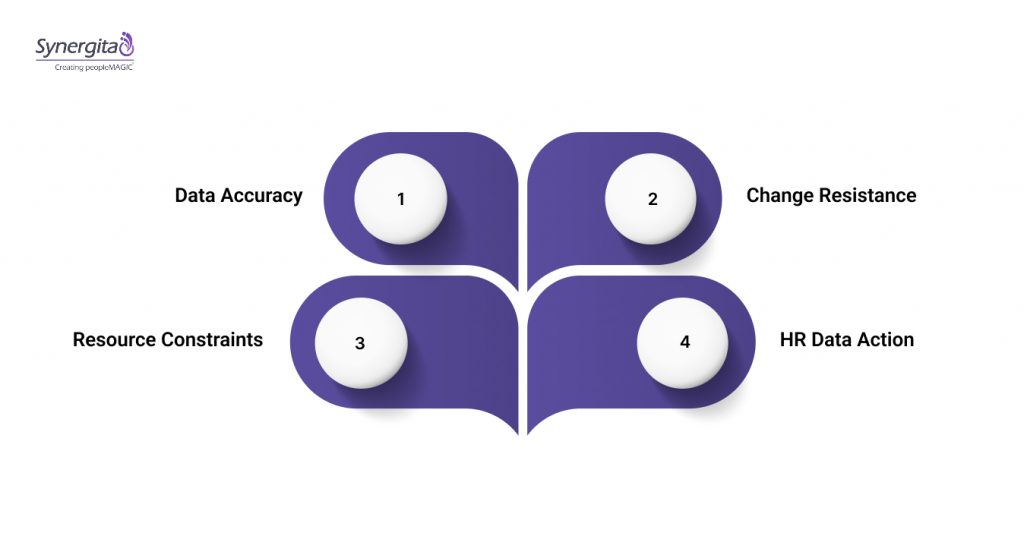
Measuring HR effectiveness is essential, but it’s not without its challenges. While many organizations strive to collect and analyze data, the process can often be hindered by a range of obstacles.
Addressing these challenges head-on is crucial for building a successful HR measurement strategy.
1. Data Quality and Accuracy Issues
Poor data quality can lead to misleading insights. Inaccurate or incomplete data can distort HR’s impact on the business.
How to Overcome It:
- Standardize Data Collection: Ensure consistent processes for collecting performance reviews and surveys.
- Invest in HR Systems: Use reliable tools to gather and process data efficiently.
- Regular Audits: Routinely check data for accuracy and correct errors.
2. Resistance to Change Management
Employees or leaders may resist new HR measurement systems or technologies due to unfamiliarity or fear of change.
How to Overcome It:
- Clear Communication: Explain the benefits and value of new systems to all stakeholders.
- Training and Support: Offer training to ensure smooth adoption.
- Start Small: Begin with pilot programs to demonstrate value.
3. Resource Constraints and Budget Limitations
Limited budgets and resources can prevent HR from implementing advanced measurement systems.
How to Overcome It:
- Leverage Existing Tools: Maximize the potential of current HR systems.
- Prioritize Metrics: Focus on tracking key metrics that align with business goals.
- Outsource When Necessary: Outsource non-strategic tasks to free up resources for measurement.
4. Interpreting and Acting on HR Data
Collecting data is only half the battle—turning it into actionable insights is where many HR teams struggle.
How to Overcome It:
- Set Clear Objectives: Align metrics with organizational goals.
- Use Dashboards: Visualize data for easy interpretation.
- Create Actionable Insights: Ensure data leads to clear actions for improvement.
Conclusion
Measuring HR effectiveness is a critical step toward building an agile and high-performing workforce.
By tracking the right metrics, from employee engagement and turnover to operational efficiency and development outcomes, HR leaders can identify strengths and areas that need improvement.
These insights empower HR teams to make informed decisions that align talent management with broader organizational goals.
Synergita’s advanced solutions offer everything needed to monitor these key metrics seamlessly.
With real-time analytics, continuous feedback mechanisms, and AI-driven insights, Synergita enables HR professionals to transform data into decisive action that drives sustainable growth.
Why Choose Synergita?
- Align individual and organizational goals with precision using Synergita’s OKR management.
- Streamline continuous performance reviews and 360-degree feedback.
- Enhance employee engagement with recognition and communication tools.
- Leverage AI-powered dashboards for actionable insights.
- Integrate seamlessly with established systems for a unified workflow.
Start making HR metrics work for your business goals.
Request a demo today and discover how Synergita can transform your HR function into a strategic growth driver.
Frequently Asked Questions
1. What are the key HR metrics to track?
Key HR metrics include employee engagement rates, turnover and retention figures, quality of hire, average time to fill positions, and cost per hire. These metrics help HR understand how well recruitment and retention strategies are working and identify areas needing improvement.
2. How can HR metrics improve employee retention?
By closely tracking turnover and engagement metrics, HR can spot trends and problem areas early. This data enables targeted interventions, like improving management practices or boosting morale, to keep employees motivated and reduce turnover.
3. How do predictive analytics benefit HR?
Predictive analytics allows HR to forecast potential risks such as employee attrition or performance issues before they arise. This proactive insight helps companies intervene early, improving retention and productivity.
4. How can I reduce recruitment costs?
Implementing tools like Synergita streamlines recruitment, providing visibility into cost per hire and enabling focus on hiring quality candidates efficiently. This reduces wasted resources and lowers overall recruitment spending.
5. What’s the role of AI in HR metrics?
AI automates the collection and analysis of HR data, uncovering patterns and delivering recommendations. It helps HR teams make faster, smarter decisions, driving more effective talent management.
6. How do I use HR data to make better decisions?
Align HR metrics with business goals to gain actionable insights that improve hiring, performance management, and employee engagement, ultimately reducing costs and elevating organizational success.



